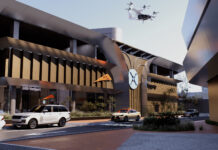Source: www.ameinfo.com
A Dubai Chamber of Commerce & Industry analysis released recently showed a strong potential and positive growth outlook for the UAE’s transportation sector. The analysis further indicated that the UAE transportation sector provides market accessibility by linking producers and consumers together in what is rapidly becoming more and more of a globalised world. The major impacts of transport on economic processes can be categorised as; (i) geographic specialisation; (ii) increased competition and (iii) increased land value.
 Since 1994, the average share of the transport sector in the UAE stood at around 5%-6% (see table 1). It is noteworthy to point out, however, that the share of the transport, storage and communications sector in total UAE GDP has in fact declined in recent years from a peak of 7.9% in 2002 to 5.0% in 2008.
Since 1994, the average share of the transport sector in the UAE stood at around 5%-6% (see table 1). It is noteworthy to point out, however, that the share of the transport, storage and communications sector in total UAE GDP has in fact declined in recent years from a peak of 7.9% in 2002 to 5.0% in 2008.
The rapid pace of the UAE‘s expansion is putting pressure on transport infrastructure. Abu Dhabi, in particular, suffers from chronic congestion problems, as the city’s population now far exceeds the original population expectations of its designers and has not developed its transport infrastructure as rapidly as in Dubai.
Furthermore, the Abu Dhabi government plans to launch a long-term investment programme to upgrade its airports, ports and public transportation system in near future. Some of the projects it has announced are the construction of an USD7bn international airport, to be completed between 2010 and 2012, and a new port facility at the Khalifa Port and Industrial Zone, located in Al Taweelah.
The government-launched “Plan Abu Dhabi 2030” outlines a major transport infrastructure overhaul to cater for a growing population estimated to reach around 3 million by 2030.
Plans for the metro, high-speed rail with Dubai, freight rail corridor and new roads are all taking shape.
The Dubai government is planning to direct funds and resources into transport infrastructure, and public authorities and public projects such as the Roads and Transport Authority (RTA), the Dubai Metro project and the Dubai Ports Authority (DPA). Whilst no specific details have been released as yet, major projects are already well underway including the new tramline in Dubai, the Dubai Metro, the parallel roads project and a possible expansion of the Jebel Ali Port.
The Dubai government has plans to invest AED300mn in the development of its aviation sector as part of its Strategic Plan 2015 which will develop Dubai as a leader in aviation and logistics. In addition, Sharjah and Ajman present some promising prospects with deregulation and FDI initiatives, following in the footsteps of Dubai and Abu Dhabi.
The long-term fundamentals that will continue to support transport infrastructural growth outlook in the UAE remain strong and robust. The 3 main transport sub-sectors outlook for the UAE are highlighted in table 2. Investments in transport are pouring in on the back of the government’s large fiscal stimulus packages to help support the UAE economy ride out the economic slowdown. What’s more, the government’s attempt to engage the private sector in infrastructural growth is encouraging which will draw in expertise and large funds to respond to the expected long-term rising demand.
Overall, as the UAE begins to recover on the back of a rise in aggregate demand due to a mix of monetary loosening, fiscal expansion and a general increase in consumer and investor sentiment, it is clear that the UAE is well on track for a robust recovery in the coming years ahead.


















